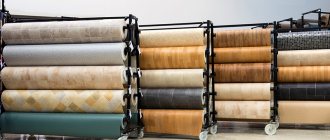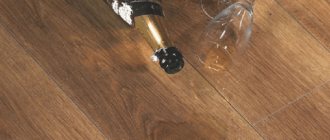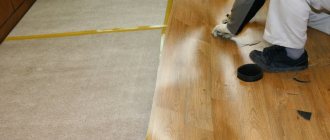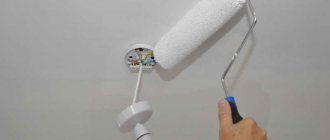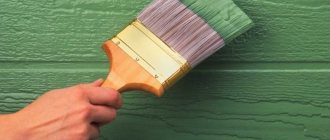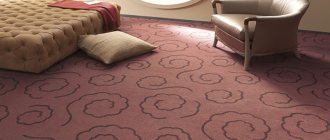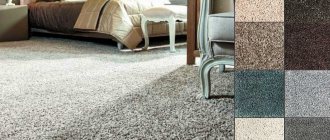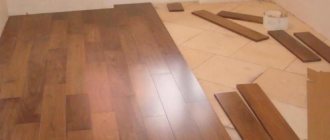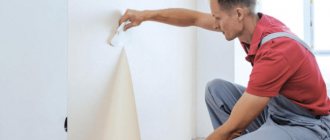SHARE ON SOCIAL NETWORKS
FacebookTwitterOkGoogle+PinterestVk
The production of new building materials does not stand still. Every year the manufacturer increases and improves the range of its products. Not long ago, tongue-and-groove moisture-resistant chipboard appeared on the building materials market. This material is highly resistant to moisture. Its unique design allows it to be used in various fields. The main characteristics and areas of application of the material can be found in this article.
Moisture-resistant tongue-and-groove chipboards are popular for flooring
Peculiarities
Tongue-and-groove chipboard is a common building material, presented in the form of panels with protrusions at the edges on one side and gutters on the other. The depth of the gutters (grooves) corresponds to the height of the protrusions, ensuring tight joining of the sheets with each other. During production, a mass of sawdust is compacted under a press with the addition of special resins, ensuring the waterproofness of the material. Therefore, as tests have shown, chipboard, completely immersed in liquid for a day, can increase by swelling by only 10%.
that have been pressed at elevated temperatures have high strength and are therefore often used for rough finishing of flooring. Special laminated chipboard is endowed with noticeable durable qualities.
During its production, a special film coating is applied to first-class products (without noticeable defects), increasing the wear resistance of the material.
How much does a chipboard sheet cost: price of material
Moisture-resistant chipboards with tongue and groove are manufactured in two standard sizes: 1830x600 mm and 2440x900 mm, the thickness of which can be 12, 16 and 22 mm. The price of moisture-resistant chipboard directly depends on the dimensions of the material and the thickness of the product.
Helpful advice! The thickness of the material should be selected based on its further purpose. Thin material should be used for cladding the ceiling or roof, and chipboard with a thickness of 22 mm is ideal for flooring and partitions.
The cost of a moisture-resistant slab 22 mm thick starts at 800 rubles
The price of moisture-resistant chipboard for a sheet measuring 2440x600 mm and 12 mm thick will be about 450 rubles. While the price for a sheet of chipboard for furniture measuring 2440x1830x16 mm will be 575 rubles. A slab measuring 2440x600 with maximum thickness can be purchased for 635 rubles. The largest slab measuring 2440x900x22 mm will cost about 800 rubles. per sheet of product. Moisture-resistant tongue-and-groove chipboards are used mainly in solid sheets.
Manufacturers and prices
In the modern market, the material is presented in a wide range. Each manufacturer produces products to suit every taste and desire of the consumer.
The most popular manufacturers of tongue-and-groove moisture-resistant chipboard are:
- "QuickDeck" Plates can be purchased from 335 rubles;
- "StroyExpert" The price starts from 365 rubles;
- "SPHERE". The cheapest stove will cost 410 rubles;
- "Plywood plus." The price range starts from 380 rubles per sheet;
- "PlitTorg-S". Prices increase from 570 rubles.
Moisture-resistant chipboards from various manufacturers are available on the market.
Manufacturer QuickDeck
QuickDeck is one of the most popular manufacturers of waterproof boards. The products of this company are in great demand in Russian cities. The product is suitable for all the jobs mentioned above.
Features of QuickDeck products:
- the material has a high level of wear resistance. According to the European standard EN 13229, the material has a service class of 33 and abrasion class AC6. These indicators allow the finished material not to lose its characteristics for 6 years. And this is only when using it in shopping centers, educational institutions, and sports sections. For residential premises, the service life can be up to 20 years;
- According to the European standard EN 312, the material has a water resistance class of P5. This indicates that the slab has a good resistance to swelling. It will swell by only 10% after a day in water;
- moisture-resistant chipboards with tongue and groove are completely environmentally friendly. The material belongs to the E1 hazard class, according to the European standard EN 13896. This means that the product does not emit harmful substances like natural wood;
- the surface of the material is resistant to direct exposure to ultraviolet rays;
- the material has a high fire resistance. Missing a lit match will not cause fire or marks on the surface;
Scheme for arranging a floor using chipboards from the manufacturer QuickDeck
- the slabs have increased sound insulation properties. A tongue-and-groove chipboard floor will not creak underfoot. And partitions made of such material will provide proper heat and sound insulation;
- the coating does not require any special care. The material is able to withstand the influence of various household chemicals.
Related article:
Chipboard: what is this?
Scope of use and classification of material History of creation. Classification of chipboard. Area of application of the material. The main differences between particle board and other sheet materials.
Advantages and disadvantages
The positive qualities of this material include:
- The high density of the slabs is characterized by the strength and rigidity of the coating, especially if the sheets are laid on logs.
- The chipboard structure evenly distributes the load over the entire floor area.
- The manufacturing technology makes it possible to eliminate dents and protrusions, maintaining the ideal evenness of the layers.
- Convenience in installation and removal of both individual elements and the entire structure due to the presence of grooves for tight joining and the small dimensions of the slab.
- Immunity to changes in temperature and humidity, harsh climatic conditions, as well as all kinds of mold and insects.
- Thermal capacity and sound insulation.
- If it complies with SanPiN standards, such chipboard can be used for finishing in kindergartens and hospitals due to the environmental friendliness of the raw materials.
- Affordable price compared to similar building materials. Reusability of used plates.
As for the disadvantages of this choice, we should highlight:
- It has an unattractive appearance, has little aesthetic features, and is not at all similar to wood trim, so it is better to use the material for rough leveling of walls or floors, and then lay decorative parquet on top of it.
- Resins added to chips during production may contain toxic substances that evaporate at room temperature. Therefore, before purchasing, it is advisable to familiarize yourself with the composition and recommendations for use - whether it is allowed to be used for making furniture and in residential buildings.
- With a low resin content, additional insulation will be required to protect the chipboard from environmental factors.
- Not suitable for wavy and convex surfaces.
- Greater weight compared to wooden panels.
These disadvantages should be taken into account before purchasing building materials.
Manufacturers
Today on the construction market you can find tongue-and-groove chipboards from a variety of manufacturers. Among them, “SPHERE”, “Plywood Plus”, “PlitTorg-S” are in wide demand.
Still, QuickDeck is very popular. This is a real construction brand, known in many cities of Russia and neighboring countries. All QuickDeck products have a list of specific features:
- the material is high quality, highly durable, meeting European standards;
- tongue-and-groove chipboards from this manufacturer are completely environmentally friendly;
- the front part of the plate easily withstands exposure to ultraviolet radiation;
- the material from this manufacturer has a high level of fire resistance;
- tongue-and-groove QuickDeck chipboards have high-quality sound insulation;
- The outer covering of the sheets does not require special care.
Where is it used?
Finishing specialists recommend installing tongue-and-groove chipboard for rough leveling of walls. A decorative coating is already applied to this base: lining, board, laminate, and so on. Also well suited for interior partitions.
The slabs perform quite well as a suspended ceiling. Unlike drywall, they do not sag, are easy to install and weigh noticeably less. Regarding floor leveling, chipboard has a special role here. Pre-leveling promotes insulation from moisture and noise, which will reassure the neighbors below. Linoleum or parquet is already applied to the surface of the sheets.
Kinds
Now we are not talking about sizes, but about the types of tongue and groove boards. This material is available in three types:
- Just tongue and groove chipboard. Moisture-resistant chipboard with molded grooves and tenons. Usually called QUICK DECK or QUICK DECK Professional.
- A tongue-and-groove chipboard with a dense polyethylene film glued to the front surface. It's called QUICK DECK Master. This option is good for the floor if high requirements for the cleanliness of the base are required for laying the finishing floor covering. Before applying the finishing coating, the film is removed along with the debris, leaving an absolutely clean surface.
- Laminated tongue-and-groove chipboard (tongue-and-groove chipboard). A laminate film is applied to the front surface of a conventional tongue-and-groove board. It's called QUICK DECK Plus. Lamination corresponds to class 34, that is, abrasion resistant. An excellent option if you previously planned to lay laminate flooring.
There is a solution for every case. The last two options are in some cases more convenient, although they are more expensive. But they save time. For example, immediately after installing each row of slabs on the floor, they can be covered with film, securing it to the walls with tape. But this option does not guarantee that dust and debris will not get under the film. It can also move. In this sense, a film glued to the surface is more reliable.
As for laminated tongue-and-groove chipboard, this option is more expensive than a chipboard + laminate set. But, if you add the cost of an additional substrate and time for installation, then this difference does not seem that big. On the other hand, the choice of colors is not nearly as wide as that of conventional laminate. In general, the choice will have to be made based on your own preferences.
How to choose?
For finishing, builders advise choosing 3- and 5-layer flooring. Among the quality indicators of sheets, tensile strength (0.2-0.6 MPa) is distinguished. Also, the plate must withstand fracture under pressure up to 25 MPa. The permissible degree of swelling should not exceed 25%.
In terms of strength and water-repellent properties, the slab is marked in two classes:
- Class A - slightly swells when exposed to water. Suitable for use in rooms with high humidity.
- Class B is less resistant to humidity, so it is advisable to use only in dry rooms.
When purchasing, you need to understand that a first-class product should not contain cracks or irregularities. Such layers can be used to level the floor.
The content of toxic formaldehyde in resins during the manufacture of chipboards must be indicated by the manufacturer on a prescriptive document - label, packaging, etc.
- E1 indicates that 100 grams of dry material contains about 10 mg of formaldehyde.
- E2 – no more than 30 mg.
- E3 – has no more than 60 mg of harmful substances per 100 g of wood.
Sheets with a high resin content are used for exterior finishing or well-ventilated and technical premises - warehouses, utility rooms and others.
Cost of Quickdeck Professional slabs
The price of a moisture-resistant board depends on its size and sales region. The latter is associated with transport costs. The table below shows the average prices for 1 sheet of the QuickDeckProfessional series in Moscow and the Moscow region as of December 2014.
| Size, mm | Number of m2 in one sheet | Retail price, rub. |
| 2440x900x12 | 2,196 | 600 |
| 2440x600x12 | 1,464 | 450 |
| 2440x600x16 | 1,464 | 500 |
| 2440x600x22 | 1,464 | 730 |
| 1830x600x12 | 1,098 | 350 |
| 1830x600x16 | 1,098 | 400 |
| 1830x600x22 | 1,098 | 480 |
A variety of formats and prices allows you to choose the required chipboard format for each case:
- Large sheets are better suited for flooring;
- smaller sizes - for finishing walls, forming interior partitions.
- for the ceiling and roof, it is advisable to use slabs with the smallest dimensions and light weight - 1830x600x12 mm.
How is it arranged?
Chipboards differ from each other in the number of layers of wood shavings: single-, three- and multi-layer. For flooring, it is better to choose multilayer sheets that have large particles of wood inside and smaller ones around the periphery. This will provide the necessary shock absorption when walking. Also, the surface of the panels can have a fire retardant coating, which gives them heat resistance.
Preparation for laying the finishing coating
Although they say that the slabs are standardized, there are differences in thickness. It is best to take all the material from one batch at once. Then there is less chance of getting changes. But, most often, small “steps” are formed at the joints - 0.5-1 mm. If this is critical, you are preparing the floor for painting, then we go through the seams with a sander, then putty. Before sanding, check that all the caps are recessed. Then we putty the seams and marks from the screws. You can use any wood putty. After drying, sand again to a smooth surface. Afterwards you can paint.
Do-it-yourself chipboard floor: the installation process is simple
No matter how you align the seams, moisture-resistant tongue-and-groove chipboard does not provide a 100% flat floor. The connections are visible under the paint layer. If carefully aligned, the seams are more difficult to determine, but still not ideal. Therefore, it is better to lay moisture-resistant chipboard on the floor if you plan to lay laminate, linoleum, parquet, parquet/engineered boards. Even vinyl tiles will lie fine.
QuickDeck
Many companies produce DSPSh. The most famous brand is Quick Deck. They developed a special form of tongue and groove - chipboard slabs of this brand do not need to be joined on a support; they are perfectly connected simply with glue. But mandatory fixation with self-tapping screws along the joists remains - at the joint or without.
Quick Deck floor panels - types and characteristics
The manufacturer of QuickDeck floor slabs claims that the dimensions match perfectly and there can be no problems when connecting. The reality is that there are still differences. There are small steps between the slabs and it is not always possible to ensure that the fragments fit together without gaps. But the quality of the surface, the consistency of shape and characteristics throughout operation, ease of installation - this is definitely there. The material is good. And both the simply sanded QuickDeck chipboard and the laminated boards received this rating. Japanese also have laminated ones.
Installation of subfloor
The rough screed is the basis for further fastening of the floor covering. Tongue-and-groove water-repellent chipboards are easy to install yourself, without involving expensive specialists. To do this, you just need to follow the sequence of actions described below.
First, timber logs are installed on the concrete screed, the distance between which is determined by the thickness of the slabs. With a sheet thickness of 16 mm, the beams need to be laid at a distance of 30-40 cm, and with a thickness of 22 mm - up to 60 cm. The floor level is indicated on the wall with a pencil. Recesses and depressions in the concrete will have to be filled with sand. Be sure to leave a small gap of 20 mm around the perimeter near the walls. If necessary, additionally insulate the floor. A layer of waterproofing is laid on the concrete under the beams, and foam plastic or glass wool is laid between the beams.
Previously, all electrical wires, protected by a corrugated sheath, are placed in specially prepared gutters. It is recommended to treat the space with substances that kill insects so that colonies of parasites do not breed under the floor.
Before fixing the plates, a place is designated for a hatch that provides access to electrical equipment.
The correct installation of the joists is determined by the building level, and if everything is in order, special paper is laid on top of the frame to prevent squeaking when walking. A hole for the hatch is marked and cut on the panels.
After this you can lay chipboard. The covering begins on the side of the room opposite to the exit. The laid panel is fixed with self-tapping screws, the first of which is screwed into the center, and the rest at the edges, to ensure uniform laying of the coating. The screw head should not protrude above the surface, so it is advisable to recess it by at least 1 mm. The area of one sheet must cover at least three logs in order not to lose rigidity and not bend.
To make the grooves and protrusions more tightly connected to each other, craftsmen recommend treating them with construction glue or mastic.
The second, third, and so on until the end is joined to the first sheet. It is recommended to place the slabs so that the joints between them pass over the beams. If you plan to cover the floor in a narrow corridor, then the stiffeners should be located across the track.
Any irregularities that arise during installation are sanded down, after which linoleum can be laid.
On the concrete floor
The concrete is primed to ensure maximum leveling of the surface. To ensure the evenness of the screed, pouring occurs using a level and special metal guides. The gypsum mixture is poured from the far corner so that there are no impurities or bubbles in the solution.
Tips for choosing
Tongue-and-groove chipboards must have characteristics such as bending strength, tensile strength and minimal tendency to swell. If we are talking about arranging a floor covering, chipboard sheets should be thicker, at least three-layer. It is best that they consist of 5 layers. For finishing ceiling and wall coverings, tongue and groove sheets with a minimum thickness are quite suitable.
Do not forget that another important requirement for choosing chipboard is the name of the manufacturer. When purchasing building materials, you should not consider cheaper products from unknown companies.
Popularity of tongue and groove connections
This connection, due to its design features, does not allow the parts to move relative to each other, thereby creating the most even floor possible. In the case of waterproof chipboard, if you seal the joint with glue, you end up with a completely sealed structure. You can even do without a waterproofing layer.
In addition, tongue and groove has other advantages. Thus, a more uniform distribution of load in the connection planes is noted. The strength of such a connection is much higher than when attaching plywood or chipboard using nails or self-tapping screws.
The tongue and groove connection in the floor slabs reliably protects the finishing coatings from possible damage. When installing slabs without tongues and grooves, there are always gaps between such materials. Even if the slabs are perfectly aligned, they will still differ in height. There will be a sharp angle on the edge of the slab - this is where expensive modern finished floors break and wear out.
Docking nodes
The quality of the flooring depends on the proper joining of the slabs and assemblies to each other and their correct installation to the joists or other base.
A few requirements that must be met:
- When joining conventional plates, be sure to leave a gap of 1 mm between them.
- The length of the screws should be three times the width of the sheet.
- The sheets are attached to the bars in increments of 15-20 cm, and in the middle of the sheet - 25-30 cm.
- If the joints of the slabs do not hit the logs, then a transverse sheathing is sewn to the horizontal beams.
When installing tongue-and-groove sheets, the joints are compacted with gentle blows of a hammer on a die with a groove cut from the remains of chipboard.
Correct joining of tongue and groove slabs
The main types of fastening elements for joists are metal anchors, brackets, corners or self-tapping screws on dowels.
Preparatory work
To install the main floor, you need to prepare a leveling base made of chipboard on which it will be laid.
Features of a chipboard subfloor
When constructing a base floor, it is necessary to leave gaps from the walls to prevent deformation of the sheets during seasonal expansion.
In places where moisture is likely to get in (bathroom, bathhouse), laying a subfloor made of wood-based material is not recommended.
Dark spot where chipboard is flooded with water
Advantages, disadvantages
Decisions have arguments for and against. Here, the reasons to turn to chipboard as an option for covering floors and walls are:
- Moisture resistance. For a wooden coating, the water repellency parameter is important, and it is respected here.
- Lightweight installation technology. It is convenient to work with tongue and groove.
- Formation of an even seam-joint. If the technology is followed, it does not swell or rise.
- No creaking.
Negative points:
- High price. Despite the production technology aimed at lowering the price, tongue and groove is not available to all users.
- Non-ideal geometry. For a clear joint, smooth edges are required, which are rare.
